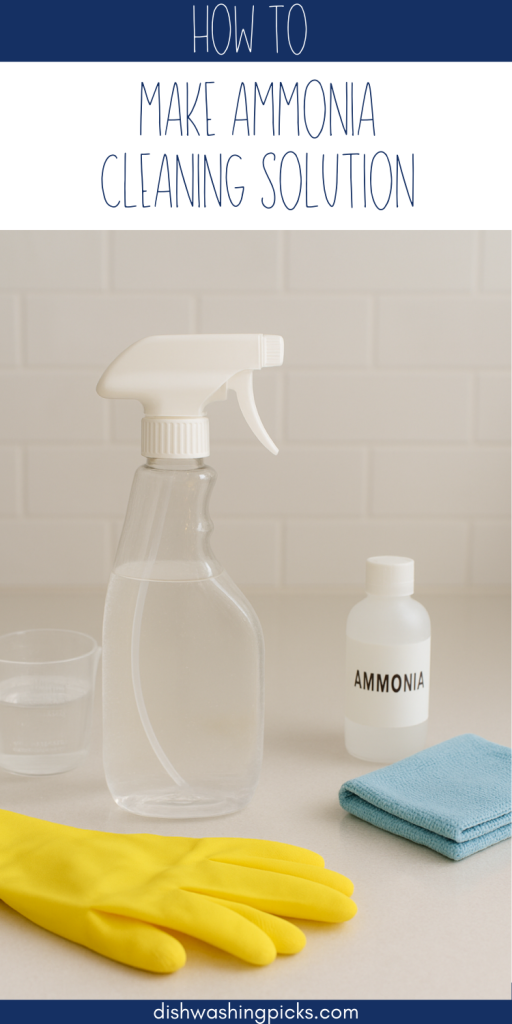
Why Ammonia, Anyway?
If you’ve ever wondered how your grandmother’s windows always looked spotless or how her kitchen counters seemed to sparkle, chances are ammonia had something to do with it. This old-school cleaner has been around forever—and for good reason. It’s strong, inexpensive, and works on all kinds of messes, from greasy stovetops to streaky glass.
But here’s the thing: you don’t always need to buy premixed bottles at the store. With the right know-how, you can mix up your own ammonia cleaning solution at home. It saves money, gives you control over the strength, and—bonus—you get to feel like a mini scientist while doing it.
So, what goes into it? Let’s peek at the ingredients.
What You’ll Need (Your DIY Cleaning Kit)
Here’s the beauty of it—you don’t need anything fancy. Just a few basics you probably already have:
- Household ammonia (the clear, unscented kind works best)
- Water (preferably warm for better mixing)
- A spray bottle or container
- Optional extras: a few drops of dish soap for greasy jobs, or a splash of vinegar if you’re tackling tougher grime (but never mix ammonia with bleach—seriously, don’t even try).
Imagine lining these up on your kitchen counter—it’s like setting up a little cleaning station that rivals anything you’d buy prepackaged.
Mixing the Solution (The Easy Recipe)
Alright, let’s get into the “how.” Making ammonia cleaner is basically about dilution—too strong and it’s overwhelming, too weak and it won’t get the job done. Here’s a simple formula:
- General-purpose cleaner: Mix 1 cup of ammonia with 3 cups of water. Pour it into a spray bottle, and you’re ready to go.
- For greasy surfaces (like stovetops): Add a teaspoon of dish soap to the mix above. Shake gently, and you’ve got yourself a grease-cutting powerhouse.
- For windows and glass: Go lighter—about 2 tablespoons of ammonia per quart of water. This gives you streak-free shine without the heavy smell.
And just like that—you’ve turned plain ammonia into a customized cleaner for different jobs around the house.
Where (and Where Not) to Use It
Now, here’s the part most people wonder: “Okay, cool, but can I use this everywhere?” The short answer: almost, but not quite.
Great for:
- Glass, mirrors, and windows
- Greasy stovetops, ovens, and grills
- Bathroom tiles and sinks
- Laundry (a splash in the wash can help with stains)
Avoid on:
- Natural stone (like granite or marble—it can damage the finish)
- Painted or varnished wood
- Electronics and screens
Think of ammonia as your go-to for tough, hard surfaces—not the delicate stuff.
Tips for Safe and Effective Use
Ammonia is powerful, which is great for cleaning but means you’ve got to use it wisely. A few golden rules:
- Always work in a well-ventilated area. Open a window or turn on a fan.
- Wear gloves if your skin is sensitive—it can be harsh.
- Never, ever mix ammonia with bleach. (Seriously, that combo makes toxic fumes.)
- Label your spray bottle so nobody mistakes it for water.
Pro tip: make small batches. Fresh solution always works better than one that’s been sitting for months.
Wrapping It Up
So there you have it—your own DIY ammonia cleaning solution. It’s cheap, fast to make, and incredibly versatile. From streak-free windows to grease-fighting in the kitchen, this old-school cleaner still holds up today.
Next time you’re tempted to grab that overpriced bottle of “all-purpose cleaner,” try thinking of it this way: with just a little ammonia and water, you can make a cleaner that’s every bit as effective—without the fancy label.
